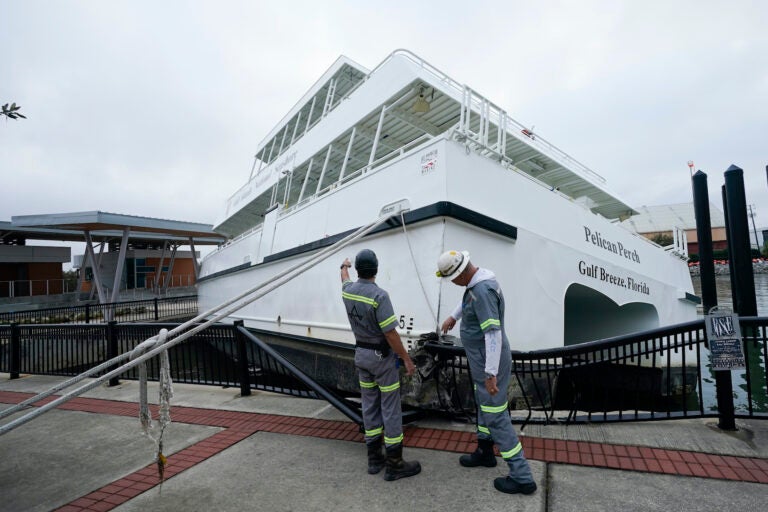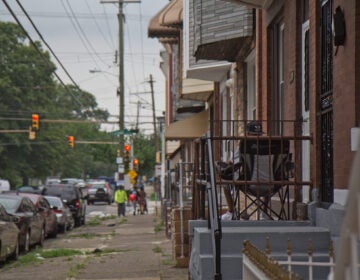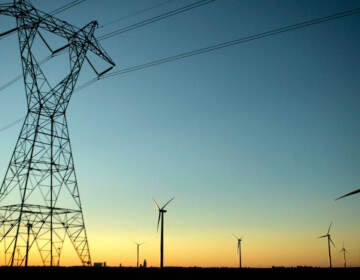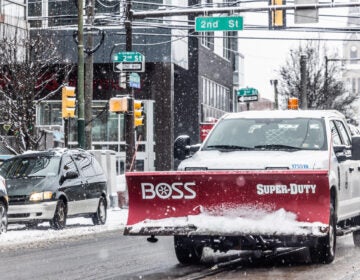Rescuers reach people cut off by Gulf Coast hurricane
Sally's remnants were over South Carolina on Thursday afternoon and were expected to move into the Atlantic within 24 hours.

Workers look over a damaged ferry, Thursday, Sept. 17, 2020, in Pensacola, Fla. (AP Photo/Gerald Herbert)
Rescuers on the Gulf Coast used high-water vehicles Thursday to reach people cut off by floodwaters in the aftermath of Hurricane Sally, even as flooding remained a problem along rivers and creeks swollen by the storm’s heavy rains.
Across southern Alabama and the Florida Panhandle, homeowners and businesses began cleaning up, and officials inspected bridges and highways for safety, a day after Sally rolled through with 105 mph winds, a surge of seawater and 1 to 2 1/2 feet of rain in many places before it began to break up.
Sally’s remnants were over South Carolina on Thursday afternoon and were expected to move into the Atlantic within 24 hours. A rainmaker to the end, what was left of the storm was forecast to dump as much as 8 inches in isolated areas in the Carolinas and southern Virginia, prompting warnings of widespread flash flooding and “moderate” river flooding. As much as 8 inches of rain had fallen in central Georgia by midday.
In hard-hit Pensacola and surrounding Escambia County, where Sally’s floodwaters had coursed through downtown streets and lapped at car door handles on Wednesday before receding, authorities went door-to-door to check on residents and warn them they were not out of danger.
“Please, please, we’re not out of the woods even if we’ve got beautiful skies today,” said Escambia County emergency manager Eric Gilmore.
Laura Coale, communications director for Escambia County, Florida, said rescue crews were taking a secondary pass through flooded areas Thursday afternoon to see if anyone who declined to leave earlier would like to evacuate. Officials’ biggest concern was keeping people off the roads so power trucks can work and people can clean debris safely.
Florida Gov. Ron DeSantis urged Panhandle residents not to let their guard down even though the hurricane had passed. “You’re going to see the rivers continue to rise,” DeSantis said after an aerial tour of the Panhandle.
Most rivers fed by the storm were cresting in Alabama and the Panhandle on Thursday, although the Shoal, in Florida was still rising, expected to crest by late Thursday or Friday, said Steve Miller of the National Weather Service in Mobile, Alabama. Near Crestview, Florida, portions of Interstate 10 and U.S. Highway 90 — the two main roadways running east to west through the Panhandle — were closed.
Crews carried out at least 400 rescues in Escambia County, Florida, by such means as high-water vehicles, boats and water scooters, authorities said.
Rescuers focused their efforts Thursday on Innerarity Point, a narrow strip of land close to Pensacola that is home to waterfront homes and businesses. Floodwaters covered the only road out, though authorities said no one was in immediate danger.
Richard Wittig and his family were among scores of people hemmed in by floodwaters on an island at the tip of the point. Two generators were powering his house, fueled by 30 gallons of gasoline Wittig bought ahead of the storm.
“If I didn’t have a working generator, we’d be dead. Nobody can get to us,” said the 77-year-old Wittig, who said he and his son rely on oxygen machines to keep them alive.
The Florida National Guard said it had deployed about 500 soldiers and airmen to help local authorities evacuate 113 people, though it did not say when and where the rescues took place.
In Alabama, on both sides of Mobile Bay, National Guard soldiers from high-water evacuation teams used big trucks Thursday to rescue at least 35 people, authorities said.
About 35 miles inland, a swollen Murder Creek cut off access between the Alabama towns of Brewton and East Brewton, inundating a grocery store, a tobacco shop, a park and more. Residents behind a police roadblock gazed at the neighboring city across fast-moving water covering a bridge.
“Mama, look. Water’s all the way up in here!” 11-year-old Rachana Matthews said.
East Brewton resident Brenda Davenport said it took only four hours for the water to rise. “It could take two days for it to go down,” she said.
Picking up soggy debris in her yard in Orange Beach, Alabama, Janice Sullivan swore she would never ride out a hurricane again. She and her daughter huddled in a second-floor bathroom as Sally blew ashore. The winds grew so violent Sullivan feared the roof would fly off.
“You could hear everything hitting the house,” she said. “You could hear the house moving back and forth. It was literally moaning and cracking.”
A few people cleaned up in Bristol Park, a creekside neighborhood where as much as 4 feet of water filled brick homes north of Pensacola.
Susan Cutts’ parents fled rising water inside their home into the garage, where they desperately called for help on a dying cellphone until aid arrived.
“They were on top of their car when they got to them,” Cutts said.
At least one death, in Alabama, was blamed on the hurricane. More than 427,000 homes and businesses in Florida, Alabama and Georgia were without power as of Thursday afternoon, down from more than a half-million a day earlier.
A section of the main bridge between Pensacola and Pensacola Beach collapsed after it was hit by a barge that broke loose during the storm.
At a downtown marina, at least 30 sailboats, fishing boats and other vessels were found clumped together in a mass of fiberglass hulls and broken docks. Some boats rested atop sunken ones. The hurricane also drove two large ferry boats into a concrete seawall and left them grounded. The boats had been purchased with BP oil spill money.
Associated Press reporters Russ Bynum in Savannah, Georgia; Jeff Martin in Marietta, Georgia; Kim Chandler in Montgomery, Alabama; Tamara Lush in St. Petersburg, Florida; and Curt Anderson in Miami also contributed.

Get daily updates from WHYY News!
WHYY is your source for fact-based, in-depth journalism and information. As a nonprofit organization, we rely on financial support from readers like you. Please give today.





